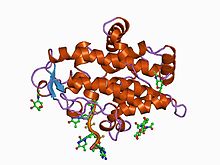| Nuclease S1 | |||||||||
|---|---|---|---|---|---|---|---|---|---|
| Identifiers | |||||||||
| EC no. | 3.1.30.1 | ||||||||
| CAS no. | 37288-25-8 | ||||||||
| Databases | |||||||||
| IntEnz | IntEnz view | ||||||||
| BRENDA | BRENDA entry | ||||||||
| ExPASy | NiceZyme view | ||||||||
| KEGG | KEGG entry | ||||||||
| MetaCyc | metabolic pathway | ||||||||
| PRIAM | profile | ||||||||
| PDB structures | RCSB PDB PDBe PDBsum | ||||||||
| |||||||||
| S1-P1 nuclease | |||||||||
|---|---|---|---|---|---|---|---|---|---|
 P1 nuclease in complex with a substrate analog P1 nuclease in complex with a substrate analog | |||||||||
| Identifiers | |||||||||
| Symbol | S1-P1_nuclease | ||||||||
| Pfam | PF02265 | ||||||||
| Pfam clan | CL0368 | ||||||||
| InterPro | IPR003154 | ||||||||
| SCOP2 | 1ak0 / SCOPe / SUPFAM | ||||||||
| CDD | cd11010 | ||||||||
| |||||||||
Nuclease S1 (EC 3.1.30.1) is an endonuclease enzyme that splits single-stranded DNA (ssDNA) and RNA into oligo- or mononucleotides. This enzyme catalyses the following chemical reaction
- Endonucleolytic cleavage to 5'-phosphomononucleotide and 5'-phosphooligonucleotide end-products
Although its primary substrate is single-stranded, it can also occasionally introduce single-stranded breaks in double-stranded DNA or RNA, or DNA-RNA hybrids. The enzyme hydrolyses single stranded region in duplex DNA such as loops or gaps. It also cleaves a strand opposite a nick on the complementary strand. It has no sequence specificity.
Well-known versions include S1 found in Aspergillus oryzae (yellow koji mold) and Nuclease P1 found in Penicillium citrinum. Members of the S1/P1 family are found in both prokaryotes and eukaryotes and are thought to be associated in programmed cell death and also in tissue differentiation. Furthermore, they are secreted extracellular, that is, outside of the cell. Their function and distinguishing features mean they have potential in being exploited in the field of biotechnology.
Nomenclature
Alternative names include endonuclease S1 (Aspergillus), single-stranded-nucleate endonuclease, deoxyribonuclease S1, deoxyribonuclease S1, Aspergillus nuclease S1, Neurospora crassa single-strand specific endonuclease, S1 nuclease, single-strand endodeoxyribonuclease, single-stranded DNA specific endonuclease, single-strand-specific endodeoxyribonuclease, single strand-specific DNase and Aspergillus oryzae S1 nuclease.
Structure
Most nucleases with EC 3.1.30.1 activity are homologous to each other in a protein domain family called Nuclease S1/P1.
Members of this family, including P1 and S1, are glycoproteins with very distinguishing features, they are:
- a requirement for three zinc ions cofactors,
- containing common active site motifs and
- requires an acidic pH for catalysis.
- contains three glycans bound to the amino acid asparagine via N-glycosylation
- two Disulphide bridges between cysteine residues.
These requirements and distinguishing features are responsible for function efficacy. It is an enzyme and these four features are needed for enzyme functionality. The three zinc ions are vital for catalysis. The first two zincs activate the attacking water in hydrolysis whilst the third zinc ion stabilizes the leaving oxyanion.
Properties
| Nuclease S1 | |||||||
|---|---|---|---|---|---|---|---|
| Identifiers | |||||||
| Organism | Aspergillus oryzae | ||||||
| Symbol | NucS | ||||||
| UniProt | P24021 | ||||||
| |||||||
| Nuclease P1 | |||||||
|---|---|---|---|---|---|---|---|
| Identifiers | |||||||
| Organism | Penicillium citrinum | ||||||
| Symbol | NuP1 | ||||||
| UniProt | P24289 | ||||||
| |||||||
Aspergillus nuclease S1 is a monomeric protein of a molecular weight of 38 kilodalton. It requires Zn as a cofactor and is relatively stable against denaturing agents like urea, SDS, or formaldehyde. The optimum pH for its activity lies between 4-4.5. Aspergillus nuclease S1 is known to be inhibited somewhat by 50 μM ATP and nearly completely by 1 mM ATP. 50% inhibition has been shown at 85 μM dAMP and 1 μM dATP but uninhibited by cAMP.
Mechanism
This zinc-dependent nuclease protein domain produces 5' nucleotides and cleaves phosphate groups from 3' nucleotides. Additionally, the side chain of tryptophan located in the cavity in the active site and its backbone supports the action one of the zinc ions. Such mechanisms are essential to the catalytic function of the enzyme.
Uses
Aspergillus nuclease S1 is used in the laboratory as a reagent in nuclease protection assays. In molecular biology, it is used in removing single stranded tails from DNA molecules to create blunt ended molecules and opening hairpin loops generated during synthesis of double stranded cDNA.
See also
- Mung bean nuclease, similar activity but probably not homologous
- DNA/RNA non-specific endonuclease, non-homologous family with similar DNA/RNA activity but accepts double-stranded substrate better
References
- ^ Balabanova LA, Gafurov YM, Pivkin MV, Terentyeva NA, Likhatskaya GN, Rasskazov VA (February 2012). "An extracellular S1-type nuclease of marine fungus Penicillium melinii". Marine Biotechnology. 14 (1): 87–95. Bibcode:2012MarBt..14...87B. doi:10.1007/s10126-011-9392-5. PMID 21647618. S2CID 17856850.
- Podzimek T, Matoušek J, Lipovová P, Poučková P, Spiwok V, Santrůček J (February 2011). "Biochemical properties of three plant nucleases with anticancer potential". Plant Science. 180 (2): 343–51. doi:10.1016/j.plantsci.2010.10.006. PMID 21421379.
- Romier C, Dominguez R, Lahm A, Dahl O, Suck D (September 1998). "Recognition of single-stranded DNA by nuclease P1: high resolution crystal structures of complexes with substrate analogs". Proteins. 32 (4): 414–24. doi:10.1002/(sici)1097-0134(19980901)32:4<414::aid-prot2>3.0.co;2-g. PMID 9726413. S2CID 24233161.
- Yang X, Pu F, Ren J, Qu X (July 2011). "DNA-templated ensemble for label-free and real-time fluorescence turn-on detection of enzymatic/oxidative cleavage of single-stranded DNA". Chemical Communications. 47 (28): 8133–5. doi:10.1039/c1cc12216a. PMID 21629944.
- Wrede P, Rich A (November 1979). "Stability of the unique anticodon loop conformation of E.coli tRNAfMet". Nucleic Acids Research. 7 (6): 1457–67. doi:10.1093/nar/7.6.1457. PMC 342320. PMID 41223.
- Wiegand RC, Godson GN, Radding CM (November 1975). "Specificity of the S1 nuclease from Aspergillus oryzae". The Journal of Biological Chemistry. 250 (22): 8848–55. doi:10.1016/S0021-9258(19)40751-5. PMID 171268.
Further reading
- Desai NA, Shankar V (January 2003). "Single-strand-specific nucleases". FEMS Microbiology Reviews. 26 (5): 457–91. doi:10.1111/j.1574-6976.2003.tb00626.x. PMID 12586391.
| Enzymes | |
|---|---|
| Activity | |
| Regulation | |
| Classification | |
| Kinetics | |
| Types |
|